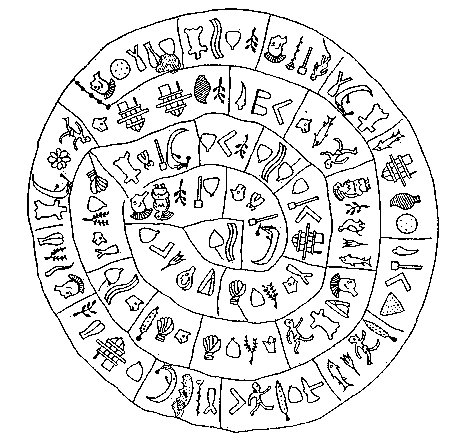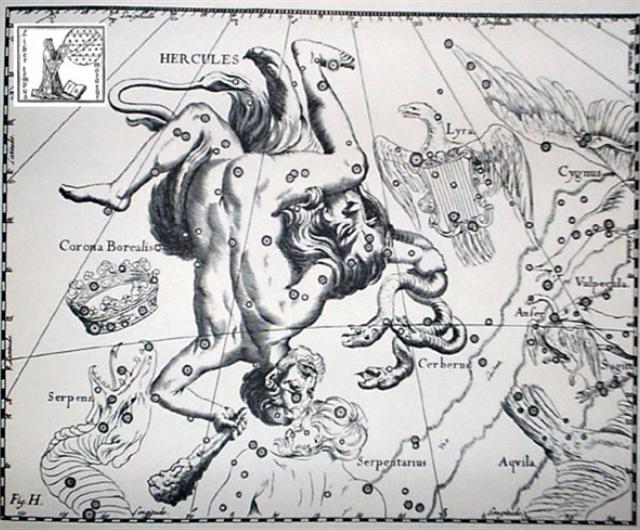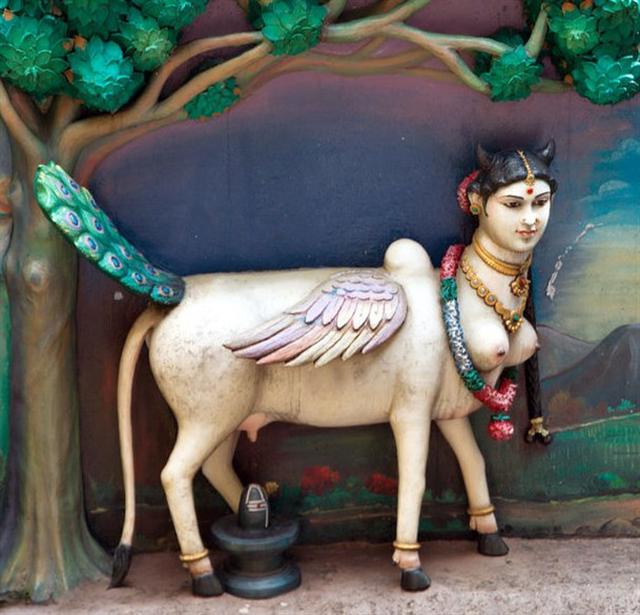8-1. Heidelberg Man tamed
the Fire, they stated yesterday in a TV program describing the
Super Volcano outbreak which unfortunately eliminated
Neanderthal Man from Mother Nature. Homo Sapiens
survived only because he had spread over such a vast area
that there were still inhabitable places for him where he could keep on
living.
The enormous feat by Heidelberg Man of taming the fire around 600,000
years ago must have dwarfed the much simpler task of keeping
track of the positions of the stars and planets high up in the night
sky, I thought.
Then I recalled the epos of Gilgamesh (→
the one who lights the fire), said to be the earliest myth
remembered today.
...
Without taking
part in the heated discussion on the interpretation of the
very name Gilgamesh - dGIS.GIN.MEZ/MAS, and other forms -
one can mention that GIS means 'wood, tree', and MEZ/MAS a
particular kind of wood, and that there are reasons for
understanding our hero as a true Prometheus
...
And from there I remembered (→)
the odd statement that Gilgamesh was 'two thirds a god',
which made me think of (→)
glyph number 242 at the Fire
Tripod (Al Safi), because 2 / 3 * (366 - 3) = 242 (→ 2 *
121). At the time of Bharani (80 + *41 = 121) the Full Moon
would ideally have been
at the Fire Tripod at right ascension day *296 - *41 = *255
→ *214 + *41.
... The Hawaiian woman who was
interviewed chuckled because the assassination of Captain
Cook coincided with the day we have named All Hearts' Day
- when in February 14 (2-14) the war-god Kuu
returned to power ...

|
July 11 (84 + 108) |
12 |
13 |
14 (195) |
 |
 |
 |
 |
|
Ea7-23 |
Ea7-24 →
288 |
Ea7-25 (242)
→ 72 * 5 = 360 |
Ea7-26 |
|
kua tuu - te hau tea |
tagata rere -
te mauga |
kua rere - te manu kai i te kai |
kua rere koia |
|
Kaikai. 1. Cat's
cradle, in which patterns are made by moving
a thread through the fingers of both hands,
and are accompanied by the recitation of
verses (one of the main pastimes of yore).
2. Sharp: also 'to sharpen' used instead of
hakaka'ika'i. Vanaga. 1. Mastication,
to eat heavily. 2. Sharp, cutting, edge of a
sword, point of a lance; moa tara kaikai,
cock with long spurs. Churchill. |
|
REVERSED NAKSHATRA → CLOSE TO THE FULL MOON: |
|
DENEB OKAB (Tail of the Eagle) =
δ
Aquilae (Ant.)
(294.0),
α VULPECULAE (Little Fox)
(294.9) |
ν
Aquilae (Ant.) (295.0),
ALBIREO - Hen's Beak =
β
Cygni
(295.5) |
ALSAFI (Fire Tripod) =
σ
Draconis
(296.0),
μ
Aquilae (296.3),
ι
Aquilae (Ant.)
(296.8), κ Aquilae (Ant.) (296.9) |
ε Sagittae (297.1),
σ Aquilae (Ant.) (297.4),
SHAM (Arrow) = α Sagittae
(297.8)
*256.0
= *297.4 - *41.4 |
.jpg) |
|
Jan 9 (79
+ 295) |
10 (80 +
295) |
11 (81 + 295) |
12 |
|
"Nov 29 |
30 |
"Dec 1 |
2 (336 →
8 * 32) |
|
NOV 6
(310) |
7 |
8 |
9 |
From the Tail of the Old Eagle (Deneb Okab)
ideally visible close to the Full
Moon in July 11 at glyph number 240 (→
2 / 3 * 360) to the end of line Ea7 there were 16 days, i.e.
presumably a
reflection so to say of the ancient method of waiting to the
return for a heliacal star to become visible.
|
July 24 |
25 |
26 |
27 (208 →
256 - 48) |
 |
 |
 |
 |
|
Ea7-36 |
Ea7-37 |
Ea7-38 |
Ea7-39 (256 → 4 * 64) |
|
ka rere - i te hatu hoi |
ki te manu ariga ruku
hia |
te tamaiti |
te raa - te ragi |
|
Ruku.
(Also rukuruku): To dive; to fish
underwater; diving; i-turu-era au ki tai,
he-ûi koai te tagata era, e-ruku-mai-era i
te îka, i te ura, as I went down to the
sea, I saw who those people were, who were
fishing underwater for fish and lobsters.
Vanaga. To bathe, to immerse, to swim face
down, to dive, to leap into the water from a
height. Hakaruku, to cover with
water, to immerse, to submerge, to moisten,
to wash, to drink. P Mgv.: ruku, to
dive, to plunge. Mq.: úku, to dive,
to immerse. Churchill. |
|
REVERSED NAKSHATRA → CLOSE TO THE FULL MOON: |
|
GREDI (Goat) =
α
Capricorni
(307.2),
σ
Capricorni (307.5),
ALSHAT (The Sheep) =
ν
Capricorni
(307.9) |
Al Sa’d al Dhabih-20
(Lucky One of the Slaughterers)
/
Ox / Heard Boy
(Buffalo)
DABIH =
β
Capricorni
(308.0),
κ
Sagittarii (308.1),
SADIR (Hen's Breast) =
γ
Cygni (308.4),
PEACOCK =
α
Pavonis
(308.7)
*267.0 = *308.4 - *41.4 |
KHUFU
OKUL =
π
Capricorni
(309.6),
BOS =
ρ
Capricorni
(309.9)
ARNEB
(α Leporis)
MINTAKA (δ Orionis) |
KHAFRE
ο
Capricorni (310.2),
θ
Cephei (310.5)
HEKA (λ
Orionis)
ALNILAM (ε
Orionis) |
|
Jan 22 |
23 |
24 |
25 |
|
"Dec 12 |
13 |
14 |
15 (349) |
|
NOV 19 |
20 |
21 |
22 (*246)
→ 2 * 123 |
|
INVISIBLY CLOSE TO THE SUN: |
|
χ
Cancri (125.2),
BRIGHT FIRE =
λ
Cancri (125.4)
*84.0 = *125.4 - *41.4 |
AVIOR =
ε
Carinae (126.4),
φ
Cancri (126.8)
*85.0 = *126.4 - *41.4 |
Ο Ursae Majoris (127.4)
*86.0 = *127.4 - *41.4 |
Pushya-8 (Nourisher)
υ Cancri (128.1),
θ
Cancri (128.2) |
Could the Nourisher
|
GEMINI: |
|
7 |
Punarvasu
the two
restorers of goods |
α and β
Gemini
Castor and
Pollux |
Bow and
quiver |
July 12
(193) |
|
CANCER: |
|
8 |
Pushya
the
nourisher |
γ, δ, and θ
Cancri
Beehive |
Cow's udder,
lotus, arrow
and circle |
July 27
(208) |
possibly refer to the Udder for the newborn
off-spring (te
tamaiti)?
Tama. 1.
Shoot (of plant), tama miro, tree shoot;
tama tôa, shoot of sugarcane. 2. Poles, sticks,
rods of a frame. 3. Sun rays. 4. Group of people
travelling in formation. 5. To listen attentively
(with ear, tariga, as subject, e.g. he
tama te tariga); e-tama rivariva tokorua
tariga ki taaku kî, listen carefully to my
words. Tamahahine, female. Tamahine (=
tamahahine), female, when speaking of
chickens: moa tamahine, hen. Tamâroa,
male. Vanaga. 1. Child. P Pau.: tama riki,
child. Mgv.: tama, son, daughter, applied at
any age. Mq.: tama, son, child, young of
animals. Ta.: tama, child. Tamaahine (tama
1 - ahine), daughter, female. Tamaiti,
child P Mq.: temeiti, temeii, young
person. Ta.: tamaiti, child. Tamaroa,
boy, male. P Mgv.: tamaroa, boy, man, male.
Mq.: tamaóa, boy. Ta.: tamaroa, id. 2.
To align. Churchill. In the Polynesian this [tama
na, father in the Efaté language] is
distinguished from táma child by the accent
tamā or by the
addition of a final syllable which automatically
secures the same incidence of the accent,
tamái,
tamana ...
Churchill 2
This in turn made me remember the sum 123 + 118 = 241
(→ 2 / 3 * 360 +
1) of the
Phaistos Disc. At the bottom of its lower (as I
have guessed it) side there is a pair of glyphs, one of
which could be perceived as the outline of a femal
breast:

The other sign (my
number 16) could then illustrate the Milky Way
river.
 |
 |
 |
 |
 |
 |
 |
 |
 |
 |
|
11 |
12 |
13 |
14 |
15 |
16 |
17 |
18 |
19 |
20 |
 |
 |
 |
 |
 |
 |
 |
 |
 |
 |
|
21 |
22 |
23 |
24 |
25 |
26 |
27 |
28 |
29 |
30 |
→
241 + 1 = 242 → NOVEMBER 18 (*242).
The Sun dates did not move,
instead it was the starry dome
of the night sky which appeared
to move due to the precession.
... The
verdicts concerning the
familiarity of ancient Near
Eastern astronomers with the
Precession depend, indeed, on
arbitrary factors; namely, on
the different scholarly opinions
about the difficulty of the
task. Ernst Dittrich, for
instance, remarked that one
should not expect much
astronomical knowledge from
Mesopotamia around 2000 B.C.
'Probably they knew only
superficially the geometry of
the motions of sun and moon.
Thus, if we examine the simple,
easily observable motions by
means of which one could work
out chronological determinants
with very little mathematical
knowledge, we find only the
Precession.'
There was
also a learned Italian Church
dignitary, Domenico Testa, who
snatched at this curious
argument to prove that the world
had been created ex nihilo, as
described in the first book of
Moses, an event that supposedly
happened around 4000 B.C. If the
Egyptians had had a background
of many millennia to reckon
with, who, he asked, could have
been unaware of the Precession?
'The very sweepers of their
observatories would have known.'
Hence time could not have begun
before 4000, Q. E. D.
|
July 19 (200) |
20 (*121) |
21 |
22 → 22 / 7 |
23
→ 7 + 16 |
|
... Midsummer is
the flowering
season of the
oak, which is
the tree of
endurance and
triumph, and
like the ash is
said to 'court
the lightning
flash'. Its
roots are
believed to
extend as deep
underground as
its branches
rise in the air
- Virgil
mentions this -
which makes it
emblematic of a
god whose law
runs both in
Heaven and in
the Underworld
... The month,
which takes its
name from
Juppiter the
oak-god, begins
on June 10th
[161 + 16 = 177
= 354 / 2 = 6 *
29] and
ends of July
7th. Midway
comes St. John's
Day, June 24th
[177 + 14 = 191],
the day on which
the oak-king was
sacrificially
burned alive.
The Celtic year
was divided into
two halves with
the second half
beginning in
July, apparently
after a
seven-day wake,
or funeral
feast, in the
oak-king's
honour
...
 |
 |
 |
 |
 |
 |
|
Ea7-31 |
Ea7-32 (249) |
Ea7-33 |
Ea7-34 |
Ea7-35 |
|
te ariki |
te maitaki |
hoko huki - Rei
hakairia |
te hokohuki -
kiore |
te hokohuki -
kiore |
|
Iri.
1. To go up; to
go in a boat on
the sea (the
surface of which
gives the
impression of
going up from
the coast):
he-eke te tagata
ki ruga ki te
vaka, he-iri ki
te Hakakaiga,
the men
boarded the boat
and went up to
Hakakainga.
2. Ka-iri ki
puku toiri ka
toiri.
Obscure
expression of an
ancient curse.
Vanaga.
Iri-are, a
seaweed. Vanaga. |
|
REVERSED
NAKSHATRA →
CLOSE TO THE
FULL MOON: |
|
ε Pavonis, θ
Sagittarii
(302.3), γ
Sagittae
(302.5), μ
Pavonis (302.7) |
τ Aquilae
(303.8) |
20h (304.4)
304.4 = 118.4 +
186.0
η Sagittae
(304.2),
δ Pavonis
(304.4)
*263.0 = *77.0 +
*186.0 |
SHANG WEI
(Higher Guard) =
κ
Cephei
(305.2),
θ
Sagittae
(305.4),
TSEEN FOO
(Heavenly Raft) =
θ
Aquilae (Ant.)
(305.6), ξ
Capricorni
(305.8)
*264.0 = *305.4
- *41.4 |
TSO KE (Left
Flag) =
ρ
Aquilae
(306.3) |
|
Jan 17 |
18 |
19 |
20 |
21 |
|
"Dec 7 |
8 |
9 |
10 (*264) |
11 (345) |
|
NOV 14 |
15 |
16 |
17 |
18 (*242) |
|
... The
correspondence
between the
winter solstice
and the
kali'i rite
of the
Makahiki is
arrived at as
follows:
ideally, the
second ceremony
of 'breaking the
coconut', when
the priests
assemble at the
temple to spot
the rising of
the Pleiades,
coincides with
the full moon (Hua
tapu) of
the twelfth
lunar month (Welehu). In
the latter
eighteenth
century, the
Pleiades appear
at sunset on 18
November. Ten
days later (28
November), the
Lono
effigy sets off
on its circuit,
which lasts
twenty-three
days, thus
bringing the god
back for the
climactic battle
with the king on
21 December, the
solstice (=
Hawaiian 16
Makali'i). The
correspondence
is 'ideal' and
only rarely
achieved, since
it depends on
the coincidence
of the full moon
and the
crepuscular
rising of the
Pleiades ... |
|
INVISIBLY CLOSE
TO THE SUN: |
|
ω Cancri
(120.2) |
8h (121.7)
χ
Gemini (121.0),
NAOS (Ship) =
ζ
Puppis
(121.3) |
ρ
Puppis (122.0),
HEAP OF FUEL =
μ
Cancri
(122.1),
ζ
Monocerotis
(122.3), ψ
Cancri (122.6),
REGOR (Roger
backwards) =
γ
Velorum
(122.7) |
TEGMINE (The
Cover) =
ζ
Cancri
(123.3) |
AL TARF (The
End) =
β
Cancri
(124.3)
RAS ALGETHI (α
Herculis) |
 |
|
Betelgeuze (*88) |
Day of culmination |
138 |
(80 + RA / 24h * 365¼) |
225 |
|
Jan 29 (394 → 322 + 72) |
June 17 (168 → 88 + 80) |
|
365 days = 20 weeks + 15
* 15 days |
|
Thuban (*212) |
Day of culmination |
133 |
(80 + RA / 24h * 365¼) |
230 |
|
June 7 (168 - 10) |
Oct 19 (292) |
|
135 + 230 = 365 days |
|
Zuben Elgenubi (*224) |
Day of culmination |
135 |
(80 + RA / 24h * 365¼) |
228 |
|
June 17 (168 → 204 - 36) |
Oct 31 (304) |
|
137 + 228 = 365 days |
|
Ras Algethi (*260) |
Day of culmination |
135 |
(80 + RA / 24h * 365¼) |
228 |
|
July 23 (204
→
158 + 46) |
Dec 6 (340 → 292 + 48) |
|
137 + 228 = 365 days |
|
Schedir (*8) |
Day of culmination |
|
(80 + RA / 24h * 365¼) |
233 |
|
Nov
18 (322) |
March 29 (88) |
|
132 + 233 = 365 days |

|






.jpg)












